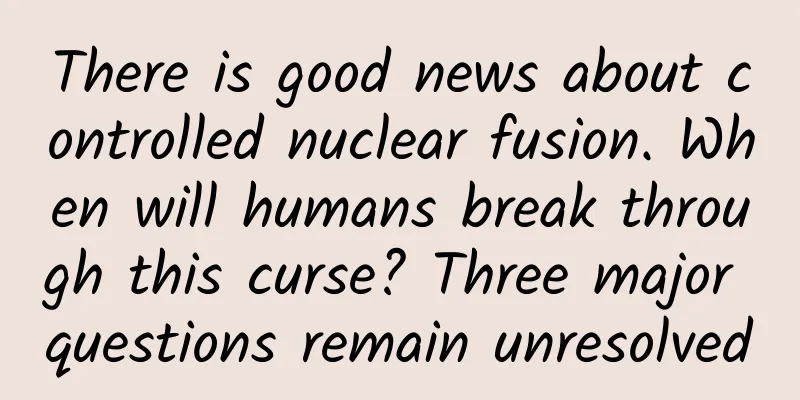There is good news about controlled nuclear fusion. When will humans break through this curse? Three major questions remain unresolved

|
Author: Gan Shudong (Science Rocket Uncle) On December 1, 2023, the world's largest experimental nuclear fusion reactor JT-60SA was officially ignited and operated in Japan. So friends, is the curse that has stuck mankind - controlled nuclear fusion will always wait for another 50 years - finally going to be lifted! I took a closer look and it's not that simple. We still need to pay attention to the key words in the news title - experimental. Yes, this controlled nuclear fusion reactor jointly built by the European Union and Japan is still just an experimental device. What it needs to accomplish is to provide more leading experimental data and technical verification support for its big brother, the ITER-International Thermonuclear Experimental Reactor Project, which is still under construction in France and attracts global attention. In essence, there is no difference between the two. They are both a controlled nuclear fusion device called a tokamak... also called a "donut", but the donut that Japan has just run is only one-sixth of the donut that France plans to run until 2035. So, what is controlled nuclear fusion? What is a tokamak device? What exactly does JT-60SA want to verify? Do we really have to wait 50 years before we can use the electricity it generates? ... Are these questions popping up in your head? Well, our goal today is to explain them to you clearly. Let's first talk about what controlled nuclear fusion is. In a word, it is a process that imitates the way energy is generated inside the sun - by fusing two light elements, usually two isotopes of hydrogen, deuterium and tritium, into a heavier element, releasing a lot of energy. In this process, the nuclei of the light elements are so strongly forced to get close that they overcome the repulsion between them and then fuse. To achieve controlled nuclear fusion, the nuclei of deuterium and tritium must first be heated to extremely high temperatures to turn them into a state called plasma. Plasma is a gas composed of charged nuclei and electrons, and its temperature can reach hundreds of millions of degrees Celsius, which is hotter than the core of the sun. At such temperatures, the nuclei of deuterium and tritium will move at extremely fast speeds and sometimes collide with each other. If the force of the collision is strong enough, they will combine into a heavier nucleus - helium. In the process, part of the mass will disappear and be converted into energy. This energy is the product of nuclear fusion, which can be used to generate electricity or other purposes. Speaking of which, there are so many ways to generate electricity, why do we love nuclear fusion alone? Because in summary, it has the following advantages that others do not have: Controlled nuclear fusion has the following advantages: First, it is rich in resources. The main fuels of controlled nuclear fusion are hydrogen isotopes deuterium and tritium. Deuterium is very high in the earth's seawater. Tritium can be produced by the reaction of lithium and neutrons. Lithium is also a widely distributed element. It is estimated that if all the deuterium in the earth's seawater is used for fusion reactions, the energy released will be enough for human use for tens of billions of years; second, it is environmentally friendly. The reaction product of controlled nuclear fusion is helium without radioactive pollution, which will not produce greenhouse gases or other harmful substances, nor will it produce long-lived nuclear waste, and basically does not pollute the environment; third, it is safe and reliable. Controlled nuclear fusion requires extremely high temperature and pressure to maintain. Once a failure or accident occurs, the reaction will stop automatically, and there will be no danger of explosion or meltdown, nor will it cause radiation hazards to the surrounding area; fourth, it has excellent economic performance. The energy output of controlled nuclear fusion is much greater than the energy input. The energy gain factor, that is, the Q value, can reach more than 10 times, that is, 50 megawatts of energy is input and 500 megawatts of energy is output. This means that controlled nuclear fusion has low operating and maintenance costs and can provide cheap electricity. However, the above are all ideals. In an actual controlled nuclear fusion reactor, it is too difficult to achieve positive energy gain. In fact, what JT-60SA has to do is to help ITER verify the problem of positive energy gain. Although this four-story-high machine is designed to maintain a plasma heated to 200 million degrees Celsius for about 100 seconds, it is much longer than previous large tokamaks. However, there is still a long way to go to stably, continuously and economically operate the plasma and output power. By the way, at this point, I have to explain what a tokamak device is. It is one of the technical paths to achieve controlled nuclear fusion, which we call magnetic confinement. The tokamak looks like a donut. Why is it a donut? Because it is actually a ring-shaped fusion chamber surrounded by magnetic coils. They can generate very strong magnetic fields, which can bind high-temperature plasma that is heated to a temperature far exceeding the limit of all heat-resistant materials on Earth, so that they can continue to maintain the correct density and temperature there, creating conditions for breaking the repulsive force to achieve the aggregation of atomic nuclei. But it currently has several major problems to solve: the first and most important is how to keep it burning. I can heat the plasma by inputting a lot of energy to ignite nuclear fusion at the beginning, but if such fusion cannot be maintained on its own later, and I have to continue to input energy into it, then what am I doing? Just igniting it for fun? Obviously not, this is the problem we want to solve urgently - positive energy gain. But the problem is that no matter how strong the magnetic field that confines the plasma is or how well it is formed, it will always encounter fish that slip through the net. Because the positive atomic nuclei or ions circling around the magnetic field lines will collide and scatter, and eventually they will inevitably drift out of the magnetic confinement field. If too much fuel drifts out, the combustion will not be able to continue. The only known solution is to make the reactor larger, so that the scattered ions take longer to reach the boundary of the plasma, so more fusion can occur during this period, which is a bit simple and crude. So we can see why ITER is 6 stories high and JT-60SA is 4 stories high. They are to provide a larger package space for the plasma. However, even with such a size, it is still not enough to maintain the continuous burning of the plasma and bring energy. It can only be regarded as a larger test device. Well, this question is still unresolved, and then the second problem that seems more practical comes. Even if we can continue to ignite nuclear fusion inside, how can we extract the energy it produces? Oh, this is another joke. Even if human technology has developed to this point, we still have to rely on boiling water to extract the energy from it. The tokamak device uses the reaction of deuterium-tritium fusion into helium to generate energy, and most of the energy will be released in the form of fast, high-energy neutrons. Neutrons are electrically neutral particles with no charge, so they don't heat the plasma, nor are they restricted by magnetic fields. Once they are produced, they will shoot everywhere. So we prepare thick shields for them, let them hit them, heat up the shields, and then use this temperature to evaporate water into water vapor, thereby powering turbines and generators to produce the electricity we want. But the problem is that the continuous bombardment of neutrons causes the shielding material to degrade over time and become very radioactive, which poses serious problems for removal, replacement and disposal. We haven't thought too much about this, and it doesn't seem to be so clean, right? Well, thirdly, the acquisition of nuclear fuel is also a problem. Currently, we use deuterium-tritium fusion reactions because they occur at the lowest energy state and lowest plasma temperature of all possible nuclear fusion fuels, so they are easier to ignite and keep ignited. Although theoretically there are a lot of deuterium and tritium on Earth, tritium does not actually exist in large quantities in nature, and it needs to be made in nuclear reactors. With today's production capabilities, we cannot produce enough tritium to continuously power ITER, let alone larger and more controlled nuclear fusion power plants that actually generate electricity. Therefore, although the JT-60SA reactor has been officially ignited and operated this time, we still have a long way to go before we can break the curse of controlled nuclear fusion. Well, after talking about the JT-60SA in Japan, let's take a look at how other countries in the world are doing on the road to controlled nuclear fusion. Let's talk about China first. We currently have the fully superconducting tokamak nuclear fusion experimental device EAST and the controlled nuclear fusion research device "China Tokamak III". EAST is the world's first fully superconducting non-circular cross-section nuclear fusion experimental device built and operated. It once set a world record of running at 120 million degrees Celsius for 101 seconds. Tokamak III is the most advanced nuclear fusion experimental device independently designed, built and operated by my country, capable of producing high-temperature plasma at 150 million degrees Celsius. Next is the United States, which has the National Ignition Facility NIF and the LCLS-II X-ray laser at the Stanford Linear Accelerator Center. NIF is the world's largest laser device, which uses the inertial confinement method to achieve nuclear fusion. In January 2022, it achieved a phenomenon called burning plasma, that is, the energy output of the fusion fuel itself exceeded the input heat, which is a key milestone on the road to controlled nuclear fusion. LCLS-II is the brightest X-ray laser in the world, capable of observing and controlling the microstructure and dynamics of nuclear fusion plasma. Then there is Japan, which, in addition to JT-60SA, also has the International Fusion Material Irradiation Experiment Facility IFMIF. This is also an international cooperation project aimed at researching and developing materials suitable for nuclear fusion reactors, using high-energy neutron beams to simulate the irradiation environment of nuclear fusion reactions. Of course, in addition to the above major controlled nuclear fusion research projects, some other countries and organizations in the world are also conducting related research, such as Germany, Britain, France, South Korea, India, Russia, Pakistan, North Korea, Israel, etc. It can be seen that controlled nuclear fusion is a scientific exploration with great potential and challenges, which requires global cooperation and innovation to be realized. I hope it will not make us wait another 50 years. This article is a work supported by Science Popularization China Starry Sky Project Author: Gan Shudong Reviewer: Sun Zhibin, Researcher, National Space Science Center, Chinese Academy of Sciences Produced by: China Association for Science and Technology Department of Science Popularization Producer: China Science and Technology Press Co., Ltd., Beijing Zhongke Xinghe Culture Media Co., Ltd. |
<<: A green alternative to plastic? Giant pandas’ favorite food is actually so precious!
>>: The new coronavirus JN.1 variant is coming? This little thing must be done well
Recommend
Crow Redemption: "Relationship Creation Theory" teaches you how to create relationships
Training course content: This theory is so advanc...
[Discussion with Prizes] Aiti Tribe Topic Exchange Activity
[51CTO.com original article] Dear friends, the 51...
What is your chance of encountering Aurora? This index is the key
Since 2019, the sun has entered its 25th activity...
Do you know how important this inconspicuous little moss is?
Disclaimer: In accordance with general ecological...
Which one is better, Sina Fuyi or Fanstong?
1.What is Fuyi? Sina Fuyi relies on Sina's ma...
Why did Steve Jobs forbid his children from using iPads at home?
Although Apple invented the iPad, as one of the im...
Science Time Machine | How did the “Big Bang” come about?
On April 1, 1948 , Gamow proposed the Big Bang th...
Do dung beetles also "pick up poop"? Why do they roll dung balls?
Expert: Zhang Qikai, Chinese Academy of Agricultu...
AI's sense of smell is far superior to that of humans? Is it a gimmick or a fact? Here comes the truth...
gossip The sense of smell is one of the earliest ...
Decipher the marketing code behind test-type H5!
In recent years, testing H5 has become popular an...
About Apple design, tell you something you don't know
Da Fei was chatting with entrepreneurs on the wee...
The most important weapon of the country, fighting for the sea
recently The world's first 16MW offshore wind...
Content is king, but platform and environment are God!
We live in an age where it seems like media compa...
The Moments has become a chaotic shopping mall: Can WeChat be saved?
There is no doubt that WeChat has become one of t...









